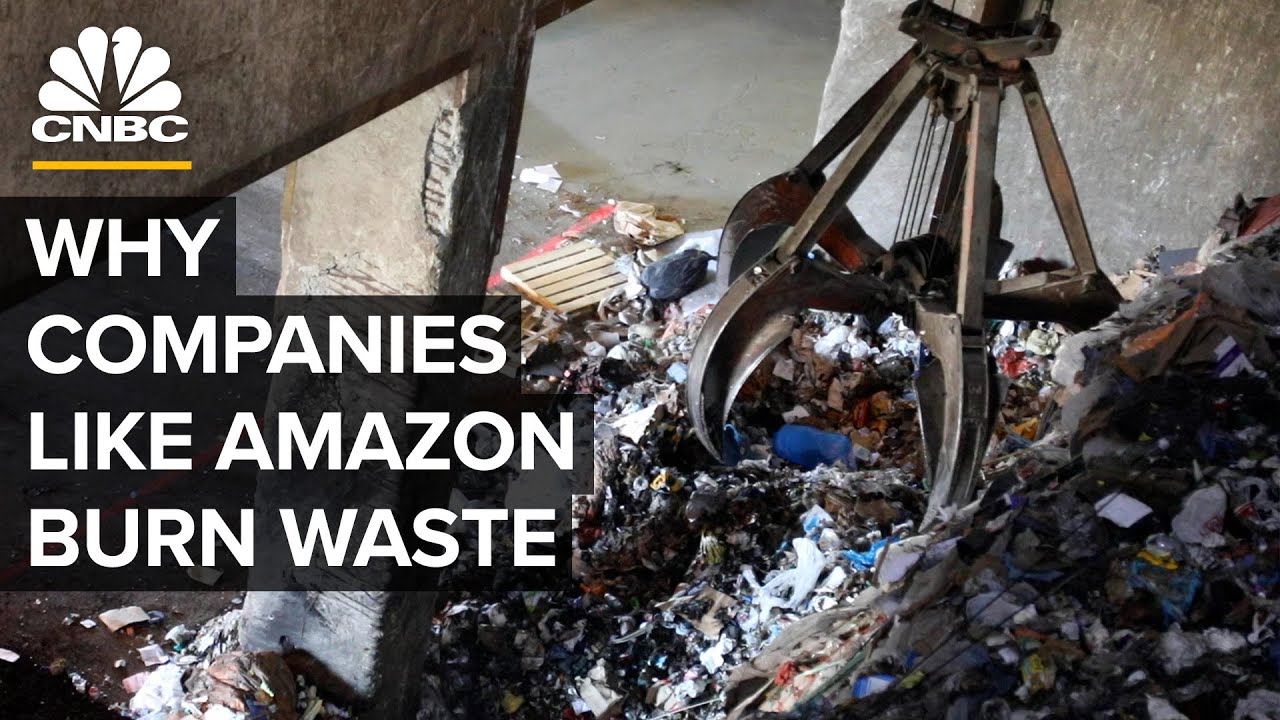Right next to a landfill in
Northern California, just Past a stack emitting
methane from rotting Garbage, there's an entirely
different type of waste Management facility that's
burning trash instead of Burying it. That crane picks up about
seven tons of trash with Each grab and it's slowly
fed into the chute for Combustion. This combustion is known as
waste-to-energy or energy Recovery because it's used
to generate electricity. The Intense heat converts water
in 21 miles of pipes around The combustor into steam
that turns a turbine. It Also creates carbon and
toxic ash. But unlike Landfills, it doesn't emit
any methane. 2,000 degrees Fahrenheit, very efficient
burn, making 23 megawatts And we only use about three
megawatts to operate the Whole facility. Part of what's burned here
is some 27,000 annual tons Of waste from big companies
like American Airlines, Quest Diagnostics, Sunny D
and Subaru. They're part of A growing movement by
companies and governments to Send less to landfills. You can see there are some
car seats and the like. This Actually comes from an
automotive manufacturer that Doesn't want to send these
materials to a landfill. Amazon and other retailers
also use this combustion to Dispose of returns they deem
unfit to recycle, resell or Donate. It is our absolute last
resort, both economically as Well as environmentally. We went to a facility run by
Covanta, one of the biggest U.S. energy recovery
companies to see the process Firsthand and find out why
big companies like Amazon And parts of Europe and Asia
have embraced burning their
Waste while most of the U.S.
keeps piling it up in Landfills. With returns pouring in at
record numbers, items like Discarded clothes generate
an estimated 5.8 billion Pounds of landfill waste
each year. With an estimated Return rate over 20%, online
purchases are more likely to Be returned than those
bought in-store. Yet Amazon Says they send no items to
landfills. We wanted to find Out how that was possible. There are a number of items
that we can't recover or are Not recyclable, and for
reasons such as legal Reasons, or hygienic
reasons, or even product Damage. And in those cases,
we do pursue energy recovery For those items. While Covanta says it
doesn't handle Amazon Returns, and Amazon wouldn't
share who does, Covanta says About 10% of its business
comes from corporate clients Like Subaru, which likes to
advertise it's building cars In zero-landfill plants. For us, we wanted to be zero
landfill because we wanted To produce the car in a very
environmentally friendly Way. What's in it for us is
we want to do the right Thing. When a major car
manufacturer like Subaru Says they're zero landfill,
they have done the reduce, The reuse, the recycle. And
what's leftover they send to A facility like a
waste-to-energy facility. It's the fastest growing
part of the business because Businesses are understanding
sustainability. And they're Understanding that one of
the major elements of Sustainability is waste
management. It's a corporate marketing
trick to say, ah, we're Going to make energy from
this. Well that always Sounds good, right? We all
need energy. And people
Don't realize what it means
is we're actually burning It. But climate experts say the
carbon-intensive process Provides a net reduction of
greenhouse gases for three Reasons. It keeps waste out
of landfills which emit far More harmful methane.
700,000 tons of metal is Recovered by the process
each year, reducing the need For mining. And it replaces
energy that could otherwise Be made by burning fossil
fuels. For every ton of garbage
that you burn, you save a Ton of CO2 that you would
otherwise create from, say, Burning a fossil fuel or
something. When you compare That to a landfill, every
legitimate study shows that The environmental impact of
a landfill is more than Sending to a waste-to-energy
facility. Landfills make up 17% of
methane emissions and the Global warming impact of
methane is 86 times greater Than carbon dioxide on a
20-year time frame. But the Bigger problem is, why do we
have so much waste in the First place? The U.S. is one
of the most wasteful Developed countries in the
world, with some of the most Trash generated per person,
per day. Marco Castaldi of The City College of New York
has been working in the Combustion space for 20
years. We produce about four pounds
per person per day. And to Give you an idea of what
that's like, that's, you Know, your outfit that
you're wearing today, Instead of taking it off and
putting it in the wash, you Throw it away. In Europe, in
Japan, the amount of waste That's generated is about
half that. While it's Indisputable that recycling
and composting are far Better, not all materials
can go that route. So what Do we do with the record 292
million tons of waste Generated by Americans each
year? More than half is
Landfilled, while about a
third is recycled and 12% is Incinerated at
waste-to-energy facilities. There are approximately 70
to 80 waste-to-energy Facilities compared to say
1,450 active landfills. In parts of Europe and Asia,
those numbers are flipped. When you look at how much
waste is actually combusted Versus landfill, it's really
kind of sad. Countries like Japan,
Denmark and Germany rely on Energy recovery far more
than landfills. In the EU, Waste incineration doubled
from 1995 to 2019. But Critics like Neil Tangri of
the Global Alliance for Incinerator Alternatives
argue some countries have Over-added capacity for the
carbon-intensive process. Denmark now realizes that it
incinerates too much waste And if it is going to meet
its greenhouse gas emissions Targets it's going to need
to reduce waste Incineration. Sweden
overbuilt waste incineration And now imports waste from
other countries to keep its Waste incinerators burning
because you can't just shut Them down. In the U.S., the first
incinerator was built in New York in 1895 and by 1905,
the city was using it to Generate enough electricity
to light the Williamsburg Bridge. More than half of U.S.
states define Waste-to-energy as a
renewable energy source. And Unlike landfills, many
governments and NGOs Consider it a source of
greenhouse gas mitigation, Including the Environmental
Protection Agency, where Susan Thorneloe leads
research on materials Management. Is it better for clean
electricity production to Burn or bury waste, and it
was hands down better to Combust it because you get
energy value from it, you
Get metals from it and
you're not producing Methane. To understand why many
environmental scientists and More and more companies
prefer combustion with Energy recovery over
landfill, let's take a look At how it works. In that big building is
where the waste is combusted And steam is made from it.
The steam then goes to a Turbine that spins because
of the steam, sort of like a Jet engine. And that then
turns the generator that Makes the electricity. Paul Gilman runs
sustainability efforts for All of Covanta's 40-plus
facilities, which he says Produce enough power for
about a million homes. The Stanislaus facility was
built in 1989. At this facility, we process
about 270,000 tons of waste A year for the county. And
that's enough to really run About 18,000 homes. This facility also recovers
more than 5,000 tons of Metal each year from the
burned remains of the waste, Like these chunks of
unrefined valuable metals That will be sold and turned
back into things like Aluminum cans and copper
pipes. You'd be amazed what people
put in their garbage. It's Everything from the
occasional mattress, but we Can go ahead and get the
metal springs out and the Like and recycle that,
something that if it went to The landfill it'd be lost
for the good. Tons of aluminum that's
recovered from these Facilities, tons of copper.
And instead of extracting it Out of the ground, okay,
that's already been done. And now it's safe to use
again. The steam can also be
captured and used again, Piped up to a mile away to
heat or cool entire
Buildings. There's a
waste-to-energy facility That's in Minnesota that
uses the heat to heat the Minnesota Twins baseball
field, and they run it Underneath the grass to keep
the grass alive in the Wintertime. In Paris, 50% of the city's
heating needs are met using Three waste-to-energy
plants. Landfills can also Harness energy from the
methane produced by rotting Organic material, but far
less efficiently. Landfill Gas generates enough power
for 810,000 U.S. homes per Year, compared to 2.3
million homes powered by far Fewer waste-to-energy
facilities. We recover almost 10 times
more energy from a given Amount of waste than is
recovered from a landfill. The EPA estimates that for
every megawatt-hour of Electricity generated,
waste-to-energy emits an Average of just over half a
metric ton of carbon dioxide Equivalent gases. Landfills
emit six times that and coal Plants emit nearly double. You don't see what people
think might be soot or dark Smoke because that's what
the air pollution control System manages. Covanta's public data shows
emissions coming out of the Stack in Stanislaus are far
below U.S. federal Standards. That's because
Covanta cleans toxins out of Its smoke and combusted
gases using an intense Filtration process with
activated carbon and Limestone scrubbers before
it comes out of the stack. The air pollution control
systems that weren't present On old fashioned
incinerators, the object of A lot of people's ire. But
today this facility Contributes less than 1% to
the particulate matter in This county. Dioxin and mercury are some
of the most dangerous
Emissions that concern
critics like GAIA, who point To facilities like one in
the Netherlands, which Regulators found was
emitting so much dioxin, it Was contaminating grass and
chicken eggs in the Surrounding area. Despite the air pollution
control equipments and the Monitoring, there are still
a lot of toxins in that Smoke from particulates to
heavy metals, lead, mercury, Arsenic, cadmium, and you
know, here in the U.S., our Monitoring systems and our
standards are much lower Than in Europe. But other scientists say air
pollution technology has Come so far in the last two
decades that most common Toxins have largely been
eliminated. Studies have been done that
have shown the amount of, Say, dioxin that's emitted
from all waste-to-energy Facilities in one year is
less, is a fraction of what Gets formed from forest
fires. But the incineration process
does still produce a lot of Toxic ash. The environmental
regulators require that we Test our ash on a regular
basis to see if we can leach Out anything like a heavy
metal, like mercury, or Cadmium or leads. And
happily, we've always passed Our tests. In Europe, they separate the
more toxic fly ash and use The safer bottom ash to make
things like concrete for Road construction. But in
the U.S., the fly and bottom Ash are usually mixed
together, making it too Toxic to be reused. So it's
buried. So behind us is the ash fill
that we use for all the ash That's come from this plant
for the 30 years it's been In operation. It's all right
there. There's probably more
municipal solid waste ash That we can use. But because
of the negative connotation,
I just don't see that
occurring. And waste-to-energy
facilities, along with Landfills, are infamous for
being built in Disproportionately poor
communities. Nobody wants to live next to
an incinerator, or really Any waste facility. And
wealthy communities and White communities generally
had the political power to Stop it. People ask, is it safe? And
my immediate answer is yes. People asked me, would you
live near one? My immediate Answer is yes, I did for
years before I knew anything About this industry. My town
that my kids grew up in was A town that had one of these
facilities. And yet, the U.S. has only
76 waste-to-energy Facilities compared to 410
in Europe. The Covanta Facility we visited is one
of only two in California. There's a real question
about why California, and Why most of the U.S. for
that matter, are so in love With our landfills. But it's
a fact. It happens that we Have a lot of land,
something Europe didn't have That luxury with. It also comes down to the
money. Landfills in the U.S. Are big business. While
waste-to-energy is a $10 Billion industry, the
overall waste management Industry is at $208 billion.
Landfill companies like Waste Management and
Republic Services have Outperformed the market
since 2015, allowing them to Keep prices down and keep
business up. For a ton of garbage, how
much does it cost to you Know, make it go away? And
if you send it to a Landfill, the nominal
average around the country Is it's somewhere between
$50 and $70 per ton. To send It to a waste-to-energy
facility is somewhere Between say $85 and $120.
One of the reasons Europe is
different is because they're Imposing, basically, a tax
on anything that would go to A landfill. But waste-to-energy is also
a moneymaker, with the EPA Estimating revenues at $20
to $30 per ton of waste. Covanta was on a big upward
swing before it went private Last year when a Swedish
investment firm bought it For $5.3 billion. In fact,
incineration is one of the Most expensive commercial
ways to generate energy and To handle waste. So why then
are companies like Amazon Burning their waste instead
of burying it? If Amazon sends all of its
returns to a landfill, Somebody could go to the
landfill and see them. And That would be a horrifying
visual. And when you burn Something, you hide the
evidence. And in some scenarios,
burning it for energy may be The better financial choice. When we think about
negotiated rates, the fees Could be closer and in other
areas, in some cases the the Waste-to-energy tip fees are
reasonably competitive with Landfill tip fees in part
because of that restriction On landfill airspace or the
lack of available places to Take that. Another consideration is the
carbon emissions from Transporting waste. Sending it to
waste-to-energy may be a 1,000-mile transport
proposition. The closest Waste-to-energy facility,
we've got to haul it by rail Halfway across the United
States to get it there Because you typically find
most waste-to-energy Facilities located in the
northeast part of the United States, in Florida, in
Minnesota. The reality is, both energy
recovery and landfills are Far less green than
reducing, reusing or
Recycling. You're arguing for last
place. We know that the Important thing to do is to
keep as much material and Particularly organics out of
the waste stream. If Amazon Returns were being
repackaged and sold to People at a discount instead
of being disposed of, then We wouldn't have to have
this question about whether It's better or worse to bury
plastic or burn it. Amazon has indeed been
adding programs to make sure More returns are resold as
used, refurbished or Liquidated and says it's
working toward a goal of Zero product disposal,
although it wouldn't give a Target date for that lofty
promise. It also wouldn't share the
breakdown for how many Returns go to energy
recovery. If you look in nature, there
is no waste. Everything's Used in some way. And so
ideally that's the focus. That's the direction that
EPA would like to go, but We're not there yet. And so
how can we best manage the Different materials? Until consumer behavior
changes, waste-to-energy Plants will continue to
offer a landfill alternative For big corporations and
local governments like Stanislaus County, where
Covanta's most recent 15-year contract extends
through 2027. Would we want to see no
waste generation? Absolutely. But we're not
there technologically yet. And we're not there policy
wise yet. So if I can make Heat out of it and use it to
heat homes, or I can make Electricity out of it and
offset coal that's being Mined, then that would be
far better than that not Happening at all.






